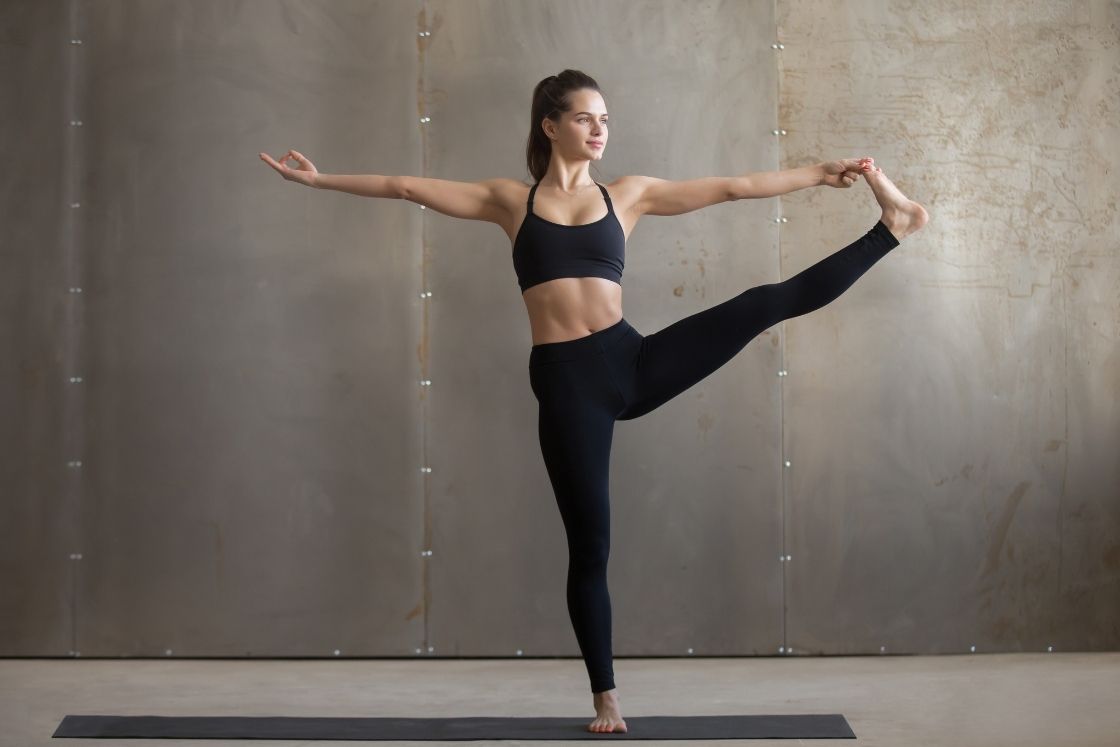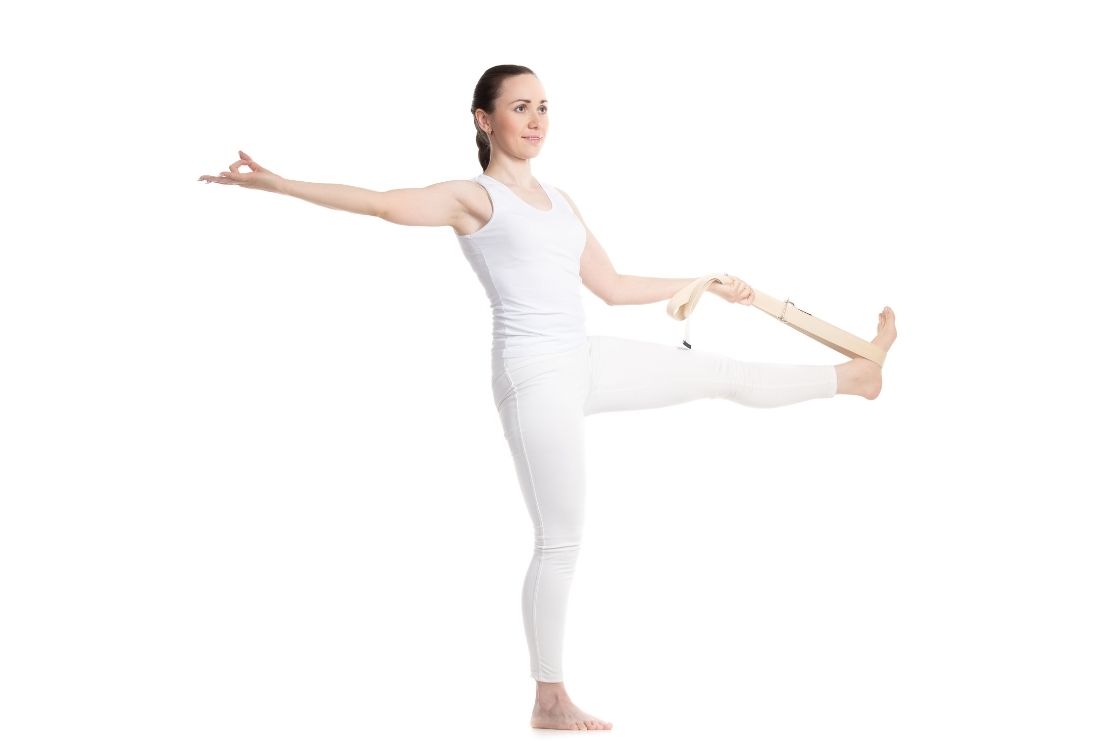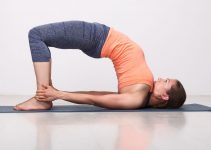
Utthita hasta padangusthasana widely known with its English name extended hand-to-big-toe pose. It lies under the category of standing balanced yogic posture.
People also refer to it as standing big toe hold pose or simply utthita padangusthasana.
Extended hand-to-big-toe is a beginner level pose involving deep stretching of hamstrings, hips, arms, and shoulders. It is well suited to improve balance, the sense of focus, and concentration.
Meaning
Utthita hasta padangusthasana comprised of five Sanskrit words. It includes:
- ‘Utthita’ which means ‘stretched’ or ‘extended’
- ‘Hasta’ refers to ‘hand’
- ‘Pada’ means ‘foot’
- ‘Angustha’ is ‘big toe’
- Asana means ‘pose.’
As per its name it is quite clear that there is an involvement of an extended leg and its big toe.
Utthita Hasta Padangusthasana Practice Guide
Before performing this asana, go through following points to begin its safe practice.
Contraindications
- Do not practice utthita hasta padangusthasana if you have low blood pressure. Holding the pose may cause headaches and dizziness among low BP individuals.
- Refrain from doing this pose if you have a broken knee, ankle, or any injury in the hip or leg.
- Never perform the pose if you have an injured shoulder or lower back. The deep stretching involved in the pose will worsen the issue.
Preparatory Poses
Perform the following combination of seated and standing poses to get into utthita hasta padangusthasana:
- Bound Angle Forward Bend (Baddha Konasana Uttanasana)
- Goddess Pose (Utkata Konsana)
- Half Moon Pose (Ardha Chandrasana)
- Intense Leg Stretch Pose (Prasarita Padottanasan)
- Dancer Pose (Natarajasana)
How to Do Utthita Hasta Padangusthasana
- Stand in mountain pose with the legs firmed to the ground.
- Bring your hands to the waistline transferring the body weight into the left leg.
- Look straight and find a point and bring your focus to it.
- Inhale and bring your right knee to the chest keeping the right hand inside of the thigh.
- Keep looking forwards and try to hook the big toe between your index finger and middle finger.
- Extend the lifted leg forward, exhale, and maintain the stretch.
- Inhale and gradually take the extended leg towards your right and turn your head to the left.
- Maintain the pose for 30 seconds keeping the spine straight.
- Inhale and bring the right leg back to the center.
- Exhale releasing the leg to the floor and bringing the right hands to the waist.
Repeat the same steps by transferring the weight into the right leg.
Cues for Beginners
- It is intimidating to gain balance initially. Begin with raising the knee keeping the ankle flexed and embrace the knee around the shin.
- Do not try to straighten the lifted leg all at once. Know your limits and increase gradually.
- Practice it against a wall to add support to your back and find balance.
Follow up Poses
- Standing Forward Fold Pose (Uttanasana)
- Wide Child Pose (Parasirita Balasana)
- Tree Pose (Vrkshasana)
Props and Modifications

Make the pose a little easier by modifying it with the help of some props:
- Yoga strap– Use a yoga strap beneath your feet while lifting it. Use your hand to stretch the leg forward and side-wise. Using the strap makes it easier to hold the pose for longer.
- Using a chair– Place a chair in front of you before beginning the pose. Place it to a distance equal to the length of your stretched leg. Now after stretching the leg forward rest it over the top of the chair.
- Combining both the chair and strap will also ease the pose.
Variations
- With a bent knee– Do not stretch the leg forward, instead, keep grabbing the big toe with a bent knee.
- Thigh variation– Follow the same steps of utthita hasta padangusthasana skipping the part of grabbing the big toe. Simply raise and stretch the leg embracing the thigh with the palms. Interlock the fingers beneath the thigh.
- Pointing the big toe upwards– After maintaining the forward stretch extend the leg towards the ceiling holding the big toe. Raise the other hand too to maintain the balance.
- Stretch without hands- Follow all the steps of the pose by keeping the hands to the waistline. Try to raise the leg up towards the ceiling.
Utthita Hasta Padangusthasana Benefits
1. Strengthens Muscle
Utthita hasta padangusthasana involves the muscles including calves, hamstrings, and ankles working on their elasticity. Holding and releasing the pose also improves the blood flow. This leads to a proper supply of oxygen and nutrition to these regions and promotes their strength.
2. Enhances flexibility
The deep stretches involved in the asana work their way to improve flexibility. The spine gets the maximum benefit and becomes flexible with the increased elasticity.
3. Improves body balance
Utthita hasta padangusthasana is all about balancing the whole body on one leg. A study has proved [efn_note] The Physical Demands of the One-Leg Balance (Utthita Hasta Padangusthasana) http://downloads.hindawi.com/journals/ecam/2012/971896.pdf [/efn_note] that the regular practice of such balancing poses ultimately improves the dynamic balance and ambulation.
4. Prevents respiratory disorders
The asana is intense enough to create pressure in and around the chest. It causes the expansion of the lung region. It helps prevent and cure respiratory disorders like asthma.
5. Improves blood circulation
Utthita hasta padangusthasana opens up the chest muscles helps in improving the blood circulation. It also reduces fat formation and cholesterol thereby preventing heart stroke and other cardiovascular diseases.
6. Better digestion
The asana exerts pressure on the abdominal cavity and produces the stress hormone on the body. It ultimately redirects the bowel movement. The asana is also helpful in secreting digestive juices and enzymes that prevent constipation.
7. Treats Lower back pain
This yogic posture helps in reducing spine stiffness. According to a study [efn_note] Is Yoga an Effective Treatment for Low Back Pain: A Research Review https://meridian.allenpress.com/ijyt/article/19/1/103/138169/Is-Yoga-an-Effective-Treatment-for-Low-Back-Pain-A [/efn_note] regularly practicing Utthita hasta padangusthasana acts as a pain reliever especially focusing on the lower back.
8. Improves mental health
Utthita hasta padangusthasana is great to practice and highly recommended to relieve anxiety. The posture enables mindfulness and helps in getting rid of any mental stress.
9. Increases concentration
During the pose, the gaze is fixed to a point. This step enhances the focus and it ultimately increases the concentration power. The proper blood flow to the brain aids in its proper functioning.
Conclusion
Utthita hasta padangusthasana comes with some challenges and a lot of benefits. Keeping the numerous benefits in mind it is worth trying and reaching beyond your limits.
Keep trying and improve gradually to reach the pose.




